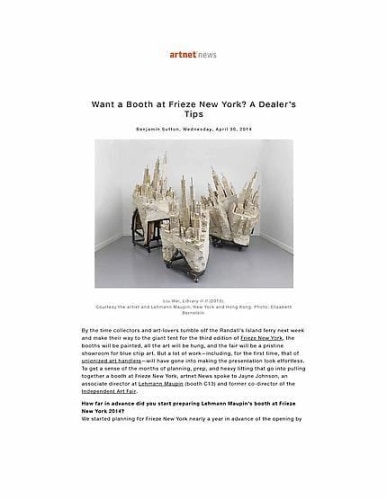
Want a Booth at Frieze New York? A Dealer’s Tips
Benjamin Sutton
By the time collectors and art-lovers tumble off the Randall’s Island ferry next week and make their way to the giant tent for the third edition of Frieze New York, the booths will be painted, all the art will be hung, and the fair will be a pristine showroom for blue chip art. But a lot of work—including, for the first time, that of unionized art handlers—will have gone into making the presentation look effortless. To get a sense of the months of planning, prep, and heavy lifting that go into pulling together a booth at Frieze New York, artnet News spoke to Jayne Johnson, an associate director at Lehmann Maupin (booth C13) and former co-director of the Independent Art Fair.
How far in advance did you start preparing Lehmann Maupin’s booth at Frieze New York 2014?
We started planning for Frieze New York nearly a year in advance of the opening by working on the curatorial concept. Since we tend to think very holistically about planning an art fair presentation, there are about 10 of us involved in the planning, including Rachel Lehmann and David Maupin. We meet as a group every week to strategize about our upcoming fairs. We share what we’ve learned from studio visits with our artists, brainstorm on curatorial concepts, review floor plans, and layout models, and from there we develop the final checklist for our presentation.
What are some logistical challenges that Frieze New York presents that distinguish it from other fairs?
Frieze New York’s tent is incredibly well done—the abundant natural light that permeates the tent helps artwork look fantastic in the space. However, since it is a temporary structure there can be some challenges to account for during the installation process. For example, we are exhibiting a large sculpture installation by Liu Wei made out of thousands of books that weighs nearly a ton. We had to reinforce the floor underneath the sculpture to be sure that its weight will be supported.
There are many booth accessories that visitors see at every fair—laptops, iPads, tape measures, checklists, and so on; what is the most essential tool that every fair exhibitor needs?
Perhaps this is less high-tech than what you might be expecting, but it’s essential to use your body— your eye, and your ear, and your brain. You have hundreds of encounters with collectors, curators and the like in a very short period of time at the fair. It’s important to really engage with people as you’re having a conversation, think deeply about what they are responding to—both visually and conceptually—and think about how to truly connect with them. The best part of participating in art fairs is building new relationships and developing new audiences for the gallery artists, so it is critical to be engaged with everyone you meet in order to maximize these opportunities. Also essential: water. As with any other endurance activity, it’s important to stay hydrated!
Lehmann Maupin’s brick-and-mortar spaces are so architecturally distinctive; does the gallery attempt to convey the feel of those locales in its art fair presentations?
As with the brick-and-mortar galleries, we take the specific situation into account when considering the architecture and layout for our fair presentations. The artwork we choose for an art fair helps shape the booth layout. As we experiment with models, we often discover interesting relationships between artworks and artists that we can highlight with the architecture of the booth.
Previous Lehmann Maupin booths at Frieze New York have been organized around major installations of works by Do Ho Suh and Tracey Emin; which artist will be the focus of this year’s presentation?
We are highlighting four artists: Kader Attia, who has recently joined the gallery and will be having his first solo show at Lehmann Maupin this fall; Liu Wei, whose sculpture on view at Frieze New York will be included in an upcoming show at the Queens Museum opening in June; Angel Otero, who will be debuting a new series of graphite dust paintings; and Nari Ward, who will be exhibiting new sculptures as well as a series of collages that he has been working on for over 20 years. Although these artists are quite different from one another, they each have their own unique way of taking their personal histories as a starting point to develop a further investigation of the world around them.
